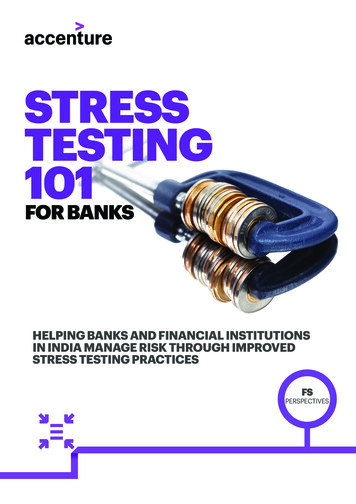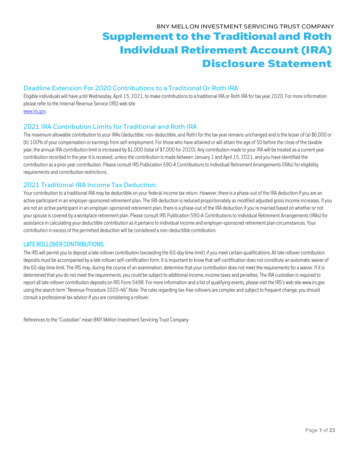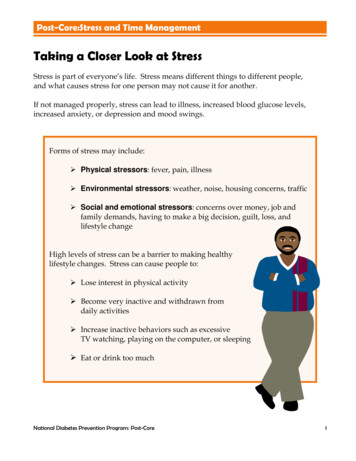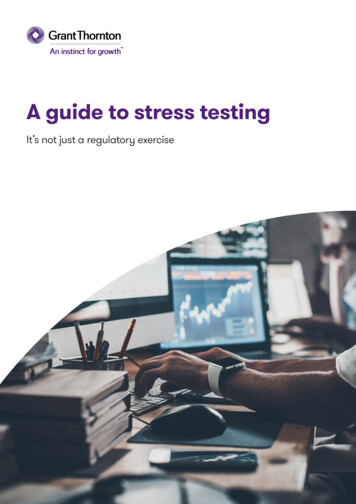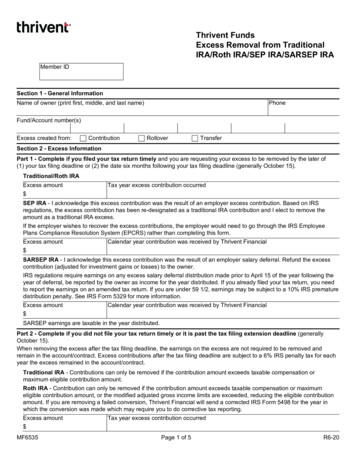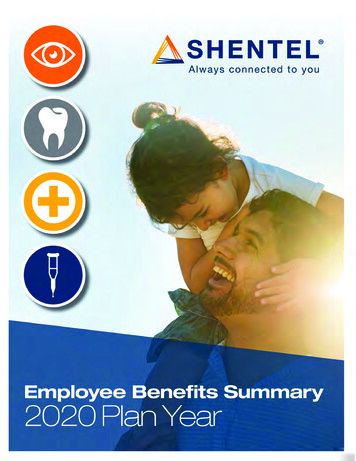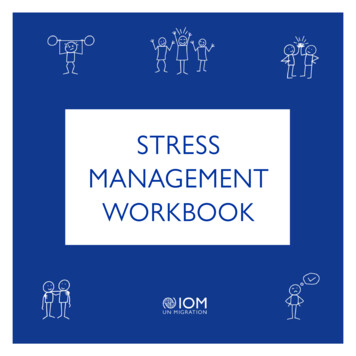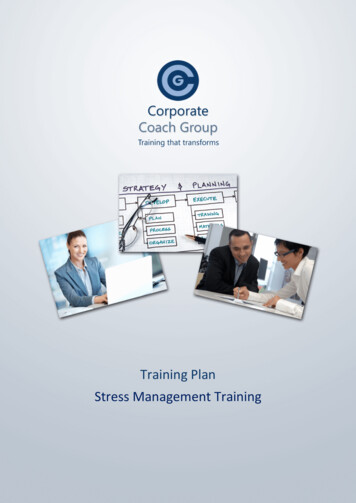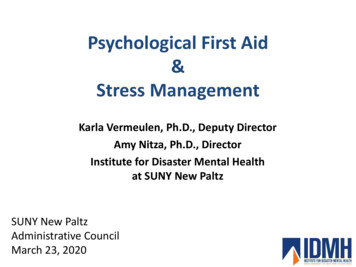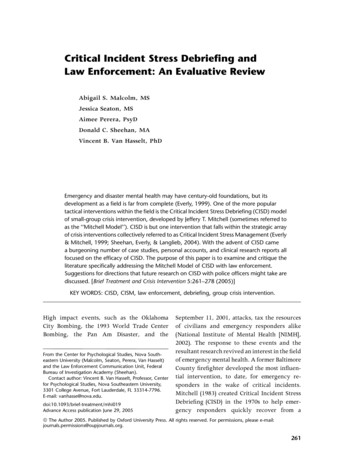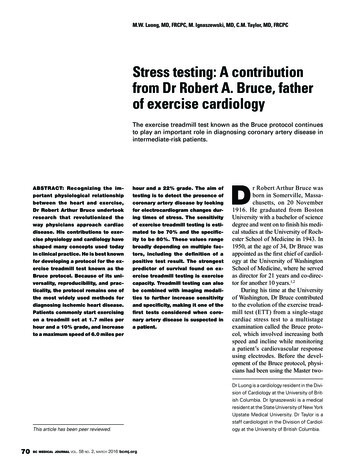
Transcription
M.W. Luong, MD, FRCPC, M. Ignaszewski, MD, C.M. Taylor, MD, FRCPCStress testing: A contributionfrom Dr Robert A. Bruce, fatherof exercise cardiologyThe exercise treadmill test known as the Bruce protocol continuesto play an important role in diagnosing coronary artery disease inintermediate-risk patients.ABSTRACT: Recognizing the important physiological relationshipbetween the heart and exercise,Dr Robert Arthur Bruce undertookresearch that revolutionized theway physicians approach cardiacdisease. His contributions to exercise physiology and cardiology haveshaped many concepts used todayin clinical practice. He is best knownfor developing a protocol for the exercise treadmill test known as theBruce protocol. Because of its universality, reproducibility, and practicality, the protocol remains one ofthe most widely used methods fordiagnosing ischemic heart disease.Patients commonly start exercisingon a treadmill set at 1.7 miles perhour and a 10% grade, and increaseto a maximum speed of 6.0 miles perhour and a 22% grade. The aim oftesting is to detect the presence ofcoronary artery disease by lookingfor electro cardiogram changes during times of stress. The sensitivityof exercise treadmill testing is estimated to be 70% and the specificity to be 80%. These values rangebroadly depending on multiple factors, including the definition of apositive test result. The strongestpredictor of survival found on exercise treadmill testing is exercisecapacity. Treadmill testing can alsobe combined with imaging modalities to further increase sensitivityand specificity, making it one of thefirst tests considered when coronary artery disease is suspected ina patient.This article has been peer reviewed.70bc medical journal vol.58 no. 2, march 2016 bcmj.orgDr Robert Arthur Bruce wasborn in Somerville, Massachusetts, on 20 November1916. He graduated from BostonUni versity with a bachelor of sciencedegree and went on to finish his medical studies at the University of Rochester School of Medicine in 1943. In1950, at the age of 34, Dr Bruce wasappointed as the first chief of cardiology at the University of WashingtonSchool of Medicine, where he servedas director for 21 years and co-director for another 10 years.1,2During his time at the Universityof Washington, Dr Bruce contributedto the evolution of the exercise treadmill test (ETT) from a single-stagecardiac stress test to a multistageexamination called the Bruce protocol, which involved increasing bothspeed and incline while monitoringa patient’s cardiovascular responseusing electrodes. Before the development of the Bruce protocol, physicians had been using the Master twoDr Luong is a cardiology resident in the Division of Cardiology at the University of British Columbia. Dr Ignaszewski is a medicalresident at the State University of New YorkUpstate Medical University. Dr Taylor is astaff cardiologist in the Division of Cardiology at the University of British Columbia.
Stress testing: A contribution from Dr Robert A. Bruce, father of exercise cardiologystep exercise test, which involvesobtaining an electrocardiogram(ECG) after a patient has repeatedlyclimbed up onto and down from asmall platform,3,4 a test that can be toostrenuous for some patients.In 1963, when Dr Bruce describedthe stress test in print, he identified angina as the development ofchest pain with exercise due to eitherunderlying coronary artery disease(CAD), a previous myocardial infarction (MI), or a ventricular aneurysm.5The ETT remains a well-proven toolfor diagnosing underlying CAD andfor determining a patient’s maximalfunctional aerobic capacity, a termthat Dr Bruce himself coined.Dr Bruce was also one of thefounders of the Seattle Heart Watchprogram in 1971, which led to thedevelopment of a database includingresults from more than 10 000 individuals who completed his treadmilltest over a 10-year span. Using ambulatory cardiac patients and healthyindividuals as test subjects, the program proved that the Bruce protocolwas both a reproducible and verifiablemethod for diagnosing underlyingheart disease. It is with this very database that Dr Bruce created the standards we use when assessing today’spatients.1,4Publishing well over 300 articles,Dr Bruce was an innovator above all,and was one of the first physiciansto contemplate the benefit of thrombolysis in acute coronary syndrome.Moreover, his merging of cardiologywith technology inspired him to successfully measure QRS and ST segments during exercise.1Dr Bruce is truly a giant of cardiovascular medicine, whose inquisitive nature led him to research thatadvanced the field. He held manyleadership positions throughout hisillustrious career, including foundingand serving as the second president ofthe Association of University Cardiologists in 1969.2,6As a believer in practising hisown medicine, Dr Bruce enjoyed ahealthy lifestyle and walked a milealong the waterfront with his wifealmost daily until his passing. Everybit the gentleman, he donned a sportcoat and tie at a celebration of his lifeand career with his closest family,friends, and colleagues on 11 February 2004 in Seattle, Washington.2,6He passed away the next day at age87 after a 13-year battle with chroniclymphocytic leukemia. His discoveries in exercise physiology and cardiology have altered the way cardiology is practised. Dr Bruce’s name willremain synonymous with one of themost extensively used screening anddiagnostic tools for detecting signs ofCAD, and he will forever be knownas the father of exercise cardiologybecause of this.Exercise treadmill testingExercise treadmill testing to identifyCAD is now a widely available andrelatively low-cost examination thathas been used for more than 60 years.7The use of the ETT has expanded toinclude testing for functional capacity, chronotropic incompetence, cardiac rehabilitation, valvular heart disease, hypertrophic cardiomyopathy,arrhythmias, and pacemaker evaluation.8-10 In addition, exercise testinghas been combined with other modalities such as radionuclide imagingand echocardiography to elicit information that may be required in selectpatients.The ETT can reveal cardiovascular abnormalities that are not seenat rest by taking measurements thatunmask these during aerobic exercise, when the heart responds to thebody’s demand for more oxygen byincreasing heart rate, stroke volume,and cardiac output. Much of this oxy-gen demand is from skeletal muscle,where oxygen extraction increases byup to threefold. As exercise intensityincreases, the increase in cardiac output by up to sixfold is due mainly to anincreased heart rate as stroke volumeplateaus. In addition, total peripheralresistance and diastolic blood pressure (DBP) decreases, while systolicblood pressure (SBP) and pulse pressure increases.10The heart rate increase during exercise is due to decreased vagal tonefollowed by increased sympathetictone. As people age, beta-receptorresponsiveness decreases, leading toa lower maximum heart rate and cardiac output in the elderly. A commonand simplified method of estimatinga person’s maximum heart rate is 220minus age. To take into account individual variability, it is common practice to conclude that patients reachtheir target heart rate at 85% of thiscalculated maximum value.11 Afterexercise, the increased vagal tone willrapidly reduce the heart rate in thefirst 30 seconds, followed by a moregradual decline back to baseline.Another value that can be obtainedfrom an ETT is a patient’s myocardial oxygen uptake. This value is estimated by the product of heart rateand SBP. This rate-pressure productis important since myocardial oxygen uptake and coronary perfusionare directly correlated. Since coronary flow can increase by up to fivefold above baseline with exercise, apatient who has obstructed coronaryarteries cannot meet this increaseddemand and ischemia results. In general, a rate-pressure product 25 000or higher indicates that a patient hasachieved an adequate workload.10 Therate-pressure product can also be usedto estimate when ischemia occurs andis a better predictor of when ischemiawill develop than the exercise testingstage.12bc medical journal vol.58 no. 2, march 2016 bcmj.org71
Stress testing: A contribution from Dr Robert A. Bruce, father of exercise cardiologyMaximal oxygen uptake (VO2max) is an additional accurate representation of a person’s cardiovascular fitness and exercise capacity, andis estimated from the peak workloadachieved on an ETT. This is usuallyexpressed in terms of a metabolicequivalent task (MET), where 1 METis equal to 3.5 mL O2 per kg per min.The VO2 max value is affected byage, gender, baseline exercise capacity and genetics.10 Metabolic equivalent tasks (METs) can be estimatedbased on the protocol used for an ETT.Patient selectionExercise stress testing to diagnoseCAD is considered appropriate in anadult patient who is able to exerciseand who has an intermediate pretestprobability of CAD with an interpretable ECG. Patients with more than1 mm of resting ST depression, leftbundle branch block (LBBB), ventricular paced rhythm, or pre-excitation syndrome (e.g., Wolff-ParkinsonWhite syndrome) will not have aninterpretable ECG and should not bereferred for the purpose of diagnosingCAD. Additional absolute contraindications and relative contraindicationsfor exercise testing are described inTable 1 and Table 2 .Test preparationPatients arriving for the test shouldbe dressed comfortably in appropriateexercising attire. They should not haveeaten in the preceding 3 hours, butmay have taken regular medicationswith sips of water. When assessing forCAD, medications that may dampen apatient’s heart rate and blood pressureresponse to exercise should be heldthe morning of the ETT. This appliesespecially to beta blockers.Test protocolsThere are several protocols that canbe used for an ETT and these are72bc medical journal vol.Table 1. Absolute contraindications for exercise testing.10Acute myocardial infarction, within 2 daysOngoing unstable anginaUncontrolled cardiac arrhythmia with hemodynamic compromiseActive endocarditisSymptomatic severe aortic stenosisDecompensated heart failureAcute pulmonary embolism, pulmonary infarction, or deep vein thrombosisAcute myocarditis or pericarditisAcute aortic dissectionPhysical disability that precludes safe and adequate testingTable 2. Relative contraindications for exercise testing.10Known obstructive left main coronary artery stenosisModerate to severe aortic stenosis with uncertain relation to symptomsTachyarrhythmias with uncontrolled ventricular ratesAcquired advanced or complete heart blockHypertrophic obstructive cardiomyopathy with severe resting gradientRecent stroke or transient ischemic attackMental impairment with limited ability to cooperateResting hypertension with SBP 200 mm Hg or DBP 110 mm HgUncorrected medical conditions, such as significant anemia, important electrolyte imbalance,and hyperthyroidismbased on patient abilities and the reason for examination. The most common protocol used is the Bruce protocol whereby patients start exercisingat 1.7 miles per hour on a 10% grade.Every 3 minutes the speed and gradeincrease to a maximum of 6.0 milesper hour and 22% grade. The Bruceprotocol is used commonly and is welldescribed in many studies involvingexercise testing.When patients have ambulationdifficulties, the large increments inworkload between stages may leadto premature discontinuation of theETT and an underestimation of thepatient’s true workload capacity.Modifications have been made to theBruce protocol and other protocolsto overcome these potential limitations.10 The modified Bruce protocol starts off at the same speed as58 no. 2, march 2016 bcmj.orgthe Bruce protocol but with an initialgrade of 0%. The Cornell, Naughton, and Balke protocols use a moregradual increase in workload and arereasonable options for patients whoare unable to ambulate comfortably.13Ramp protocols also exist wherebypatients start off with no incline andat a low speed. The incline and speedare then gradually and progressivelyincreased according to the patient’sfunctional abilities.10After an appropriate protocol hasbeen selected for a patient and the testis proceeding, it is important to recognize when stress testing should stop.The current recommendations for terminating an exercise test are listed inTable 3 and Table 4 .Once the ETT has been completed, there is an obligatory cool-downperiod. Patients are typically moni-
Stress testing: A contribution from Dr Robert A. Bruce, father of exercise cardiologytored for 6 to 8 minutes after testcompletion but may require additional monitoring of blood pressure, heartrate, or ST segments if they have notnormalized or if they remain symptomatic. Additionally, ST segmentdeviation, a relatively poor prognostic factor, may only occur during thepostexercise period.10MonitoringIt is important to monitor patients forthe development of symptoms duringand after the test. Particular attentionshould be paid to the presence of angina and dyspnea. Exercise-limitingangina is especially important because it indicates a poorer prognosis according to the Duke treadmillscore (DTS). The DTS is a validatedtool that provides both prognostic anddiagnostic information in evaluatingpatients with suspected CAD14 (seemore about this below). In addition,exercise-limiting dyspnea independent of angina has also been recognized as a worrisome ETT finding.15Exercise capacity on an ETT haslong been touted as a predictor of cardiovascular risk. In a meta-analysisby Kodama and colleagues, there wasa decrease in cardiovascular eventsof approximately 15% with every1-MET increase in aerobic exercisecapacity. Kodama also found thatsubjects who were able to exerciseto a level beyond 7.9 METs had asignificantly better cardiovascularprognosis than those who did not.16A patient’s predicted exercise ability can be estimated based on sex andage, making it important to note whatReduced leftventricularcomplianceWall motionabnormalitiesTable 3. Absolute indications to terminate exercise test.10ST elevation 1 mm in leads without pre-exisiting Q waves because of prior MI (other than leadsaVR, aVL, and V1)Drop in SBP 10 mm Hg, despite an increase in workload, when accompanied by other evidenceof ischemiaModerate-to-severe anginaCentral nervous system symptoms (dizziness, near syncope, ataxia)Signs of poor perfusion (cyanosis or pallor)Sustained ventricular tachycardia or other arrhythmia that interferes with normal maintenance ofcardiac output during exercise, such as second- or third-degree atrioventricular blockTechnical difficulties in monitoring the electrocardiogram or SBPSubject’s desire to stopTable 4. Relative indications to terminate exercise test.10Marked ST segment depression 2 mm measured 60 to 80 milliseconds after the J point in apatient with suspected ischemiaDrop in SBP 10 mm Hg, despite an increase in workload, in the absence of other evidence ofischemiaIncreasing chest painFatigue, shortness of breath, wheezing, leg cramps, or claudicationArrhythmias other than ventricular tachycardia that have the potential to become more complexor affect hemodynamic stability, such as multifocal ectopy, ventricular triplets, supraventriculartachycardia, or bradyarrhythmiasDevelopment of bundle branch block that cannot be immediately distinguished from ventriculartachycardiaExaggerated hypertensive response with SBP 250 mm Hg or DBP 115 mm Hgpatients are able to achieve as a percentage of their predicted abilities.10ECG changesThe aim of exercise treadmill testingis to detect CAD by identifying ECGchanges during times of stress, whenthere is an imbalance between myocardial oxygen supply and demand.At increasing levels of stress, production of adenosine triphosphate isdecreased and production of lactateis increased, ultimately affecting theelectrical properties of the myocar-Increased leftventricular enddiastolic pressuredium, which can be detected subsequently on the surface ECG. A patternof characteristic alterations known asthe ischemic cascade develops withreduced left ventricular compliancefollowed by localized wall motionabnormalities, increased left ventricular end-diastolic pressure, STsegment changes, and lastly angina( Figure 1 ). It is these last two findings that can be assessed on a standard ETT.10Close attention to ECG changes isneeded to identify signs of ischemia.ST segmentdeviationAnginaFigure 1. The ischemic cascade.bc medical journal vol.58 no. 2, march 2016 bcmj.org73
Stress testing: A contribution from Dr Robert A. Bruce, father of exercise cardiologyWhen looking for exercise-inducedischemia, the ST segment has longbeen the focus and is measured relative to the end of the PR segment.The baseline should be stable to determine any significant ST segment deviations, and three or more consecutive beats should be used to detect STchanges. The ST segment tangentialdirection should be measured at 60to 80 milliseconds after the J point.A positive test for ischemia shows atleast 1 mm ST depression that is eitherhorizontal or downsloping ( Figure 2 ).Upsloping ST depression, however,can be seen in up to 20% of the normal population and is therefore notdiagnostic for ischemia. If more than1 mm upsloping ST depression isidentified, the test is deemed equivocal.10 It is important to note that STchanges identified on ETT do not reliably predict the coronary artery affected. The main exception to this isin rare cases where ST elevation develops in leads without pre-existingQ waves.10Some subjects may have restingECG changes, such as T wave andST segment deviations, that normalize with exercise due to elimination ofelectric forces that are directed againsteach other, a phenomenon termedischemic counterpoise. Furthermore,ST changes in leads with existing Qwaves may represent ongoing ischemia in the territory or wall motionabnormalities from prior infarcts.10 Inpatients with underlying conductionabnormalities, interpretation of theETT is more difficult. With underlying left bundle branch block the ETTcannot be interpreted, but this is notthe case in patients with underlyingright bundle branch block (RBBB).The ECG of a patient with underlyingRBBB can still demonstrate ischemiain all leads other than V1 to V3. InRBBB, the anterior precordial leadswill usually have baseline ST depression that worsens with exercise;these changes are not associated withunderlying CAD.ECG changes other than ST segment deviations have also been implicated as signs of ischemia, st testNegativestressUpslopingST STUpslopingdepression( 1mm)depression( 1mm)Equivocalstresstest testEquivocalstressHorizontalHorizontalST STdepression( 1mm)depression( 1mm)PositivestressPositivestresstest testDownsloping STdepression ( 1mm)Downsloping STdepression ( 1mm)Figure 2. ST segment depression with exercise.74bc medical journal vol.58 no. 2, march 2016 bcmj.orgthey are less well studied and havenot been duplicated. These possiblesigns of ischemia include increases inP wave duration, particularly in leadV1, increases in R wave amplitude atpeak exercise, absent QRS shortening, increases in T wave amplitude,exercise-induced U wave inversions,and absent QT interval shortening.10ArrhythmiasExercise increases sympathetic toneand increases myocardial demand,which are both potential mechanismsfor inducing supraventricular andventricular arrhythmias. These arrhythmias are potentially dangerousin the postexercise period, when catecholamine levels are high while thepatient is still vasodilated.10Ectopic atrial arrhythmias mayoccur in subjects with underlying cardiac disease, such as rheumatic heartdisease or Wolff-Parkinson-Whitesyndrome, but may also be seen insubjects with no identified abnormalities. Atrial fibrillation and flutter maytransiently occur in less than 1% ofETTs. Generally, these transient arrhythmias are not related to underlying ischemic heart disease. This is incontrast to ventricular arrhythmias,which are the most frequent arrhythmia seen during exercise. Prematureventricular beats are more concerningwhen accompanied by a family history of sudden cardiac death, previousmyocardial ischemia, or existing cardiomyopathy. Studies have suggestedthat ventricular ectopy, particularly inthe recovery period after an ETT, maybe associated with an increased riskof death.17The development of atrioventricular (AV) block is relatively uncommon during ETT, particularly sincevagal tone is decreased during exercise. When AV block develops, it maybe related to medications, CAD, oraortic stenosis.10 Rate-related con-
Stress testing: A contribution from Dr Robert A. Bruce, father of exercise cardiologyduction abnormalities can developin patients while exercising, but thedevelopment of LBBB or RBBB withexercise is not necessarily related tounderlying CAD. However, LBBBduring exercise may be an independent risk factor for death and majorcardiac events.18 Developing RBBBduring exercise is less common thandeveloping LBBB, but may occurmore commonly in patients withunderlying CAD than in patients withLBBB.10Alternatives to ETTWhen patients are physically unableto exercise on a treadmill, alternatives to the ETT are available. ECGchanges can be recorded during pharmacological stress testing with adrenergic agents such as dobutamine orvasodilating agents such as adenosine. These agents are often used inconjunction with nuclear myocardial perfusion imaging with singlephoton emission computed tomography (SPECT), which increasesboth the sensitivity and specificity ofdetecting CAD. Stress echocardiograms can also be performed to lookfor wall motion abnormalities, whichare seen earlier than ST segmentdeviations as part of the ischemiccascade. Lastly, magnetic resonanceimaging (MRI) and computed tomography (CT) scans are also being usedincreasingly to detect CAD.10Sensitivity andspecificity of ETTThe sensitivity of ETT is estimated to be 70% and the specificity isestimated to be 80%.19 These valuesrange broadly depending on multiplefactors, including the definition of apositive ETT, prevalence of disease,underlying cardiomyopathies, andresting ECG abnormalities. For example, the sensitivity of a test increaseswith multivessel CAD, while thespecificity can be lowered if an ETTis done on a subject with resting ECGabnormalities that are more likely tolead to false-positive results. Similarly, the predictive value of an ETTis influenced by the prevalence ofCAD in the population, which can bepredicted by the patient’s underlyingrisk factors. As such, exercise testingto identify CAD is inappropriate for alow-risk, asymptomatic patient.10Prognostic value of ETTLooking at ETT results, the strongest predictor of survival is exercisecapacity, which is how much exercisea patient can sustain. One caveat isthat an ETT is often terminated whenpatients reach their target heart rate,so merely noting the time it takes fora patient to reach this stage does notindicate how much longer they wouldotherwise have been able to continue exercising. Furthermore, exercisecapacity is best assessed by calculating a patient’s workload in METs asopposed to simply indicating howmany minutes the patient exercised.There are no simple numbers ofMETs one must reach to be considered to have high exercise capacitybecause this number varies with ageand gender.10Chronotropic incompetence isanother prognostically importantvariable defined by the failure toreach 85% of the maximum predicted heart rate. Heart rate response isimportant during exertion because itis a measure of how well the patient’scardiac output matches metabolicdemands, and an impaired responsepredicts cardiac events and overallmortality.Abnormal heart rate response isalso prognostically important, and isdefined as a decline during recoveryof less than 12 beats per minute afterETT termination while the patient isstill upright. However, this value isaffected by the type of protocol used,and universal agreement on the exactheart rate decline is lacking.10Hypotension during exercise mayindicate left ventricular outflow tractobstruction, severe left ventriculardysfunction, and significant CAD,and is a marker of an increased riskof cardiac events.20 During exercise, itis abnormal to see the SBP dip belowthe resting value or drop 10 mmHg or more after an initial increase.However, the most common reasonfor hypotension during exercise isthe use of antihypertensive medications, making it important to reviewa patient’s medication profile beforetesting. Blood pressure can also riseexcessively during exercise and thistoo has been shown to predict mortality. A hypertensive response is definedby a rise of SBP to 210 mm Hg andbeyond for men and to 190 mm Hgand beyond for women.20 Furthermore, a rise in DBP of more than 10mm Hg or a rise to an absolute value beyond 90 mm Hg may also be asign of CAD.21 These hypertensiveresponses may predict an increasedrisk of developing hypertension, leftventricular hypertrophy, and cardiacevents.20Perhaps the most popular prognostic risk score used for the ETT isthe Duke treadmill score. The DTSis calculated by subtracting 5 timesthe ST depression (measured in mm)and 4 times the angina score (no angina 0, non-limiting angina 1, andtest-limiting angina 2) from the totalexercise duration (measured in minutes) on the standard Bruce protocol.Subjects are considered low risk ifthey score 5 or above, intermediaterisk if they score between 4 and -10,and high risk if they score -11 andbelow. Subjects with a high-risk DTSare much more likely to have triplevessel or left main CAD, and have areduced 5-year survival rate of 65%.14bc medical journal vol.58 no. 2, march 2016 bcmj.org75
Stress testing: A contribution from Dr Robert A. Bruce, father of exercise cardiologySummaryDr Bruce will forever be known as thefather of exercise cardiology. The easy,relatively low-cost test he developedcontinues to play an important rolein diagnosing CAD in intermediaterisk patients. The Bruce protocol allows patients to exercise on a treadmillaccording to their baseline functionalstatus, and is used to determine a patient’s exercise capacity, predict overall mortality, and stratify patient risk,irrespective of the presence of CAD.Today exercise treadmill testingis also being combined with imagingmodalities to increase sensitivity andspecificity for CAD, making the ETTa flexible test that is often used firstwhen CAD is suspected in a patient.Competing interestsNone declared.References1. Kennedy JW, Cobb LA, Samson WE. Robert Arthur Bruce, MD. Circulation 2005:111;2410-2412.2. Wenger NK, Froelicher E. In memoriam:Robert A. Bruce, MD scientist, clinician,teacher, mentor, and friend. J CardiopulmRehabil 2004;24:216-217.3. Shah BN. On the 50th Anniversary of thefirst description of a multistage exercisetreadmill test: Re-visiting the birth of the“Bruce Protocol.” Heart 2013;99:17931794.4. Wood S. Father of exercise testing,Dr Robert A Bruce, dies at age 87. 16February 2004. Accessed 21 February2015. www.medscape.com/viewarticle/784880.5. Bruce RA, Blackmon JR, Jones JW, et al.Exercise testing in adult normal subjectsand cardiac patients. Pediatrics 1963;32:742-756.6. Oliver M. Robert Bruce, 87; researcherdeveloped treadmill stress test. Los Angeles Times. 16 February 2004. Accessed24 February 2015. ruce16.76bc medical journal vol.7. Kligfield P. Historical notes: The early evolution of the exercise electrocardiogram.In: Schalij MJ, Janse MJ, van OosteromA, van der Wall EE, Wellens HJJ (eds).Einthoven 2002: 100 years of electrocardiography. Leiden, Netherlands: EinthovenFoundation; 2002.8. Morise A. Exercise testing in nonatherosclerotic heart disease: Hypertrophiccardiomyopathy, valvular heart disease,and arrhythmias. Circulation 2011;123:216-225.9. Rajala J, Taylor CM, Kamossi N, et al. Cardiac rehabilitation in BC: An approachbased on Dr Hellerstein’s model. BCMJ2013;53:153-158.10. Fletcher GF, Ades PA, Kligfield P, et al.;American Heart Association Exercise,Cardiac Rehabilitation, and PreventionCommittee of the Council on ClinicalCardiology, Council on Nutrition, PhysicalActivity and Metabolism, Council onCardiovascular and Stroke Nursing, andCouncil on Epidemiology and Prevention.Exercise standards for testing and training: A scientific statement from theAmerican Heart Association. Circulation2013;128:873-934.11. Pinkstaff S, Peberdy MA, Kontos MC, etal. Quantifying exertion level during exercise stress testing using percentage ofage predicted maximal heart rate, ratepressure product, and perceived exertion.Mayo Clin Proc 2010;85:1095-1100.12. Balady GJ, Arena R, Sietsema K, et al.;American Heart Association Exercise,Cardiac Rehabilitation, and PreventionCommittee of the Council on ClinicalCardiology; Council on Epidemiology andPrevention; Council on Peripheral Vascular Disease; and Interdisciplinary Councilon Quality of Care and Outcomes Research. Clinician’s guide to cardiopulmonary exercise testing in adults: A scientificstatement from the American Heart Association. Circulation 2010;122:191-225.13. Franklin BA, Whaley MH, Howley ET, etal.; American College of Sports Medicine.ACSM’s guidelines for exercise testingand prescription. 6th ed. Baltimore, MD:58 no. 2, march 2016 bcmj.orgLippincott Williams & Wilkins; 2000.14. Shaw LJ, Peterson ED, Shaw LK, et al.Use of a prognostic treadmill score in identifying diagnostic coronary disease subgroups. Circulation 1998;98:1622-1630.15. Abidov A, Rozanski A, Hachamovitch R, etal. Prognostic significance of dyspnea inpatients referred for cardiac stress testing. N Engl J Med 2005;353:1889-1898.16. Kodama S, Saito K, Tanaka S, et al. Cardiorespiratory fitness as a quantitative predictor of all-cause mortality and cardiovascular events in healthy men andwomen: A meta-analysis. JAMA 2009;301:2024-2035.17. Frolkis JP, Pothier CE, Blackstone EH, etal. Frequent ventricular ectopy after exe
that Dr Bruce himself coined. Dr Bruce was also one of the founders of the Seattle Heart Watch program in 1971, which led to the development of a database including results from more than 10000 indi - viduals who completed his treadmill test over a 10-year span. Using ambu-latory cardiac patients and healthy individuals as test subjects, the pro-
